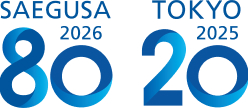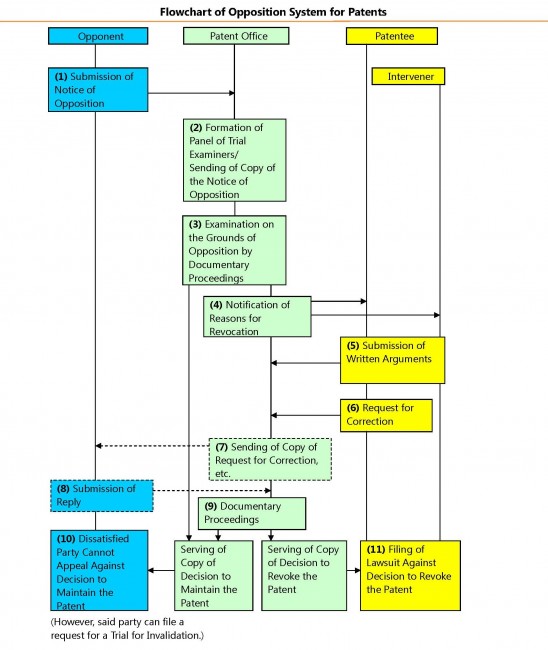[October 2014] Overview of 2014 Partial Amendment of the Japanese Patent Law
2014.10
SAEGUSA IP UPDATE
Effective Date
Not yet announced; to be stipulated by Cabinet Order.
The date on which the revised Patent Law comes into effect will be a date within one year from the date of promulgation (May 14, 2014).
1.Major Changes
(1) An opposition system for patents will be reintroduced.
(2) In a trial for patent invalidation, Requester will be limited to an interested party only.
(3) Relief in respect of time limits will be expanded.
2.Opposition System for Patents
(see corresponding numbers in accompanying flowchart)
(1) The Opponent submits a Notice of Opposition to the Commissioner of the Patent Office (Article 115 (1)).
(2) A panel of three or five Trial Examiners is formed (Article 114(1)). The Chief Trial Examiner sends a copy of the Notice of Opposition to the Patentee (Article 115 (3)). Additionally, other parties having registered rights relating to the patent, if any, are notified of the Opposition by the Chief Trial Examiner (Article 115 (4)). Said other parties receiving notification can intervene in the Opposition for the purpose of assisting the Patentee at any time before the decision of Opposition (Article 119).
(3) Documentary proceedings will be carried out by the panel of Trial Examiners (Article 118). In the event that it is determined as a result of the proceedings that the patent is maintained, a decision to maintain the patent is issued, and a copy of the decision of maintenance is served to the Patentee, Opponent, Intervener, et al. (Article 120sexies).
(4) In the event that it is found as a result of the proceedings that the patent should be revoked, the Patentee and Intervener will be notified of the reasons for revocation (Article 120quinquies (1)).
(5) The Patentee and Intervener can submit, within a designated time period, written arguments in response to the notification of reasons for revocation (Article 120quinquies (1)).
(6) The Patentee can file a request for a correction of the description, claims, or drawing(s) in response to the notification of reasons for revocation (Article 120quinquies (2)).
(7) In the event that a correction is made by the Patentee, a copy of the corrected description, claims, etc., is, in principle, sent to the Opponent, providing an opportunity to submit a reply (Article 120quinquies (5)).
(8) The Opponent can submit a reply within the designated time period (Article 120quinquies (5)).
(9) After the above-mentioned exchanges (4) to (8), a decision to maintain the patent or a decision to revoke the patent is issued, and a copy of the decision is served to the Patentee, Opponent, Intervener, et al. (Article 120sexies).
(10) In the event of a decision to maintain the patent, an adversely affected party cannot appeal against the decision to maintain the patent (Article 114 (5)). However, if the Opponent is an interested party, then the Opponent can file a request for a trial for patent invalidation (Article 123).
(11) In the event of a decision of revocation, the Patentee, Intervener, et al., can appeal (i.e., file a lawsuit) against the decision of revocation to the Tokyo High Court (the Intellectual Property High Court) (Articles 178 and 179).
3.Comparison of opposition and other systems
As a result of this patent law revision, third-party observations, oppositions, and trials for invalidation coexist and give an opportunity for third parties to provide their opinion against a patent application and a patent.
| Third-Party Observation | Opposition (Article 113) | Trial for Invalidation (Article 123) | |
|---|---|---|---|
| Party who can Submit | Any party (may be filed anonymously or by a straw man (dummy)) | Any party (may be filed by a straw man (dummy); however, may not be filed anonymously) | Real party in interest |
| Timing | Any time | Within six months from the date of publication in the Official Gazette for Patents | Any time after registration of patent |
| Reason | Novelty, inventive step, industrial applicability, secret prior art (prior right), double patenting, enablement, support, new matter, etc. | Novelty, inventive step, industrial applicability, secret prior art (prior right), double patenting, enablement, support, new matter, etc. | Novelty, inventive step, industrial applicability,secret prior art(prior right),double patenting, enablement, support, new matter, violation of correction, joint application, derivation, etc. |
| Proceedings | The Examiner and Appeal Examiners have the discretion to consider the observation. | Patentee vs. Japan Patent Office (documentary proceedings) (Article 118) | Patentee vs. Requester for a Trial for Invalidation (oral or documentary proceedings) (Article 145) |
| Appeal | The submitter cannot file an appeal. | In case of a decision to maintain the patent, the Opponent cannot file an appeal (Article 114) (a Trial for Invalidation can be used instead, if a request for an invalidation trial is possible). | In case of a trial decision to maintain the patent, the Requester of the invalidation trial can file a lawsuit against the Patentee at the Intellectual Property High Court for revocation of the trial decision(Articles 178 and 179). |
| For example, in case of a Decision of Final Rejection, Applicant can file an appeal against the Commissioner of the Japan Patent Office (Article 121). | In case of a decision to revoke the patent, the Patentee can file a lawsuit against the Commissioner of the Japan Patent Office at the Intellectual Property High Court for revocation of the decision (Articles 178 and 179). | In case of a decision to invalidate the patent, the Patentee can file a lawsuit against the Requester of the invalidation trial at the Intellectual Property High Court for revocation of the trial decision (Articles 178 and 179). | |
| Advantages/ Disadvantages | Any party can submit an observation. However, it is up to the discretion of the Examiner or Appeal Examiners whether the observation is considered. Low cost. | Any party can file an opposition, and the procedural burden is lower (only documentary proceedings). However, the opposition period is short, and there are not many opportunities for the Opponent to submit comments. Documentary proceedings alone are, in general, lower in cost than a trial for invalidation. | The period for request of an invalidation trial is long, and there are many opportunities for the Requester to submit comments. However, the Requester is limited to an interested party. The proceedings are inter partes and in general expensive. |
4.Expansion of Relief in Respect of Time Limits
(1) Time Limit for Priority Claims
1) Regarding a patent application claiming priority (domestic priority or Paris Convention priority), if there is a reasonable ground for failing to file the patent application in question within the priority period (within one year), it will be allowable to make a priority claim within the time period specified in the Ordinance of the Ministry of Economy, Trade, and Industry (Article 41 (1) and Article 43bis).
2) A priority claim statement, even if not submitted along with the patent application, may be submitted within a prescribed time period (Article 41 (4) and Article 43 (1)).
(2) Time Limit for Requesting Examination
1) In the event that there is a reasonable ground for failing to request examination before the period for requesting examination expires, a request for examination will be allowed within two months from the date on which said ground ceased to exist and within one year from the expiration of the time period for requesting examination (Article 48ter (5)).
2) When the patent is registered following the procedure of item 1) above, a third party who has worked the invention or prepared for the working of the invention during the period after the publication of the expiration of the period for requesting examination in the Official Gazette and before the publication of the filing of a request for examination in the Official Gazette, shall have a non-exclusive license on the patent (Article 48ter (8)) so as to avoid enforcement of the patent.
(3) Other Time Limits
The below-listed procedures, when not completed for reasons beyond the control of the Applicant or Patentee, may be allowed within 14 days (for overseas residents, within two months) from the date on which the reasons ceased to be applicable, but not later than six months following the expiration of the original time limit.
(i) Submission of a certificate needed to receive the benefit of an exception to loss of novelty of the invention (grace period) (Article 30 (3) and (4))
(ii) Submission of a divisional application (Article 44 (1) and (7))
(iii) Submission of a converted application (Article 46 (1) and (5))
(iv) Payment of the first- to third-year patent fees (annuities) (Article 108 (1) and (4))
(4) Explanation of “Reasonable Grounds”
The evaluation criteria for “reasonable grounds” appear to be substantially the same as those for “due care” used by the EPO.



